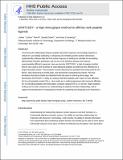SORTCERY—A High–Throughput Method to Affinity Rank Peptide Ligands
Author(s)
Reich, Lothar; Dutta, Sanjib; Keating, Amy E.
DownloadKeating_SORTCERY.pdf (2.489Mb)
PUBLISHER_CC
Publisher with Creative Commons License
Creative Commons Attribution
Terms of use
Metadata
Show full item recordAbstract
Uncovering the relationships between peptide and protein sequences and binding properties is critical for successfully predicting, re-designing and inhibiting protein–protein interactions. Systematically collected data that link protein sequence to binding are valuable for elucidating determinants of protein interaction but are rare in the literature because such data are experimentally difficult to generate. Here we describe SORTCERY, a high-throughput method that we have used to rank hundreds of yeast-displayed peptides according to their affinities for a target interaction partner. The procedure involves fluorescence-activated cell sorting of a library, deep sequencing of sorted pools and downstream computational analysis. We have developed theoretical models and statistical tools that assist in planning these stages. We demonstrate SORTCERY's utility by ranking 1026 BH3 (Bcl-2 homology 3) peptides with respect to their affinities for the anti-apoptotic protein Bcl-x[subscript L]. Our results are in striking agreement with measured affinities for 19 individual peptides with dissociation constants ranging from 0.1 to 60 nM. High-resolution ranking can be used to improve our understanding of sequence–function relationships and to support the development of computational models for predicting and designing novel interactions.
Date issued
2014-10Department
Massachusetts Institute of Technology. Department of BiologyJournal
Journal of Molecular Biology
Publisher
Elsevier
Citation
Reich, Lothar “Luther,” Sanjib Dutta, and Amy E. Keating. “SORTCERY—A High–Throughput Method to Affinity Rank Peptide Ligands.” Journal of Molecular Biology 427.11 (2015): 2135–2150.
Version: Author's final manuscript
ISSN
0022-2836
1089-8638